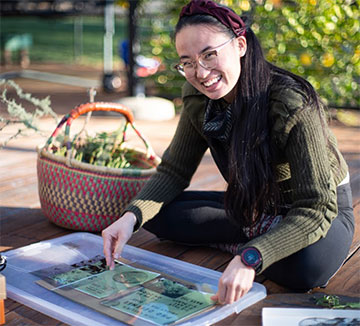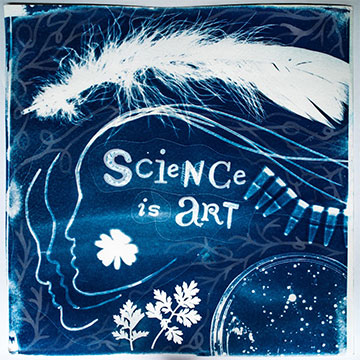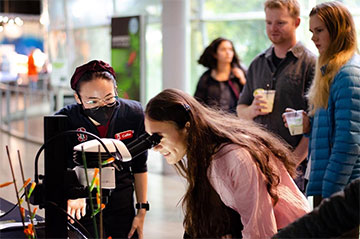
Callie Chappell creating a cyanotype sunprint. [Image: E. Dorsky]
Science has influenced art in many ways. For example, OPN recently published stories about imaging scientists using an optical toolkit to investigate artworks in the US National Gallery and about artists who create work inspired by light. But can art benefit science?
According to a recent “community page” paper published in PLOS Biology, the answer is a resounding yes. It argues that science and art can mutually reinforce each other, supporting discovery and innovation. To learn more about this idea and how it can affect a scientific career, OPN spoke with one of the authors, Callie Chappell, a professional artist and arts educator who just finished their Ph.D. in the biology department at Stanford University, USA.
How did you make the initial connection between art and science?
Callie Chappell: I grew up in rural northern Michigan, and I spent a lot of time running around outdoors with my dog, picking wildflowers and looking at trees. I enjoyed drawing the natural environment, and the artists around me really encouraged my artistic talents.
But I never imagined that I would be a scientist until many years later, when I started doing scientific research in college. I realized that a lot of the observational skills that I had developed as a kid and as an artist were actually the same sorts of skills and curiosity that you need as a scientist or an engineer.
In your paper, you argue that scientists and artists have a lot in common. Can you explain?
I think fundamentally, as a scientist or an engineer, we start with curiosity—asking how something works. And in our explorations, we make observations. We test things out, and sometimes we fail. Then we make some conclusions about what we learned, and ultimately, we create something to share—if you’re an academic researcher, a paper.

Cyanotype sunprint created by Callie Chappell. [Image: C. Chappell (art) / E. Dorsky (photo)]
And the question I had to ask myself was, well, how is this any different than the practice of creating art? Artists also look at the world with curiosity and wonder about it. And they investigate it in their own ways and create a set of products, whether that be a painting, a piece of music or a dance performance, that’s meant to communicate some sort of observation about the world.
So I thought perhaps the practice of science is actually a particular type of art practice. Maybe our aesthetic products as scientists—namely papers, conference presentations and talks—might actually be types of art that we’re creating, because, in some ways, those things are meant to go out in the world and to show someone something or make someone feel a particular way, just like art does.
How can art benefit science and scientists?
When we see science as being more like art, it creates space for more creativity. And that creativity can be the engine for creating more innovative and breakthrough ideas in our research. We can be more creative, not only with the questions that we ask but also the ways in which we might answer those questions.
Thinking like an artist can also help scientists capture a broader audience. If we can get more people interested in the things that we’re really passionate about, if we can spread the joy and the curiosity that we have in our work, it might inspire other people to want to work on that as well.
Combining science and art can also help reimagine what science is. There are many great things about science—we’ve made a lot of really cool discoveries, it’s helped a lot of people. But we have major issues with respect to diversity, equity and justice. I think we can make the community more equitable if we let different forms of knowledge and knowledge production play a role in how we do our science.
Has being an artist helped your scientific career?
Definitely. But it wasn’t immediately obvious. In high school, I would make really beautiful posters for science fairs. But for a long time, people really tamped me down. They were like, “oh, if [the poster] looks too good, it’s distracting away from the science.” So I thought I needed to keep my art and my science separate.
Then in grad school, my advisor asked if I wanted to include some of my illustrations in a review paper we were writing together. So I did some original art for that paper, and the reviewers loved it. And I thought that was so cool.

Sharing science and art at an outreach event. [Image: E. Dorsky]
That led me to join a student organization at Stanford called Science Teaching through Art, or STAR. It teaches workshops for grad students about how to integrate science and art. Through that organization, I taught grad students how to make infographics about their research.
So I was inspired to start doing scientific illustration professionally and draw these sketches of scientific talks that I shared on Twitter. People started following me online and inviting me to teach graphic-design workshops for STEM grad students at other universities during the pandemic.
Eventually, I decided I wanted to expand STEM education programming to center art from the beginning. I worked with local artists to grow a STEAM summer camp called BioJam, which was all about the intersection between biology and art.
If scientists or engineers reading this want to embrace their artistic side, where should they start?
Well, I think everyone should always start from what makes them excited. Most scientists and engineers I know have a creative pursuit. Some are secretly great at playing the guitar or go swing dancing. People have all these creative endeavors that they usually don’t talk about when they’re at work, being a scientist.
But what if you had a little mashup? What if you took your creative-writing practice and wrote a short story from the perspective of an electron traveling through your microscope? There are ways to integrate things in a playful way. And I think the first step is just to get out there and try something new.
Then you can share it on social media, for example, or you can share it with your friends and family. Many universities have organizations or clubs that are focused on the intersection between science and art. On a slightly larger scale, you can think about the professional societies that you’re a part of. Many professional societies have art–science competitions that you can enter.
OPN has an annual photo contest.
Right, you can enter the photo contest. You can also go to workshops by the Alan Alda Center for Communicating Science, or if you are a graduate student, go to ComSciCon.
You can also look into non-academic local communities, going to community centers’ and libraries’ art spaces. Even venues like local bar nights are oftentimes really excited to host events about art–science topics.
